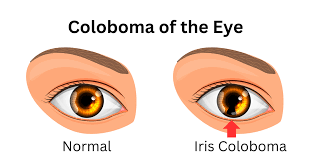Coloboma: Rare Eye Abnormality
Coloboma is a rare congenital eye abnormality that can significantly affect an individual’s vision. In this comprehensive guide, we’ll delve into the world of coloboma, exploring its causes, types, and common symptoms.
Causes and Development of Coloboma

coloboma
Understanding the origins of coloboma is essential to grasp its impact fully. Coloboma develops during early fetal development when specific structures of the eye fail to form correctly. While it can occur sporadically, there may also be genetic factors involved. Ongoing research aims to uncover the genetic mutations linked to coloboma.
Types and Locations of Coloboma
Coloboma is a complex condition, and its effects can vary depending on the part of the eye affected. The most common types of coloboma include iris coloboma (affecting the colored part of the eye), choroid coloboma (affecting the middle layer of the eye), and optic nerve coloboma (affecting the optic nerve). Each type has distinct characteristics and visual implications.
Symptoms and Effects of Coloboma
Identifying the symptoms and visual effects of coloboma is crucial for early diagnosis and management. While the symptoms can differ based on the type and location of the coloboma, common effects include blurred vision, sensitivity to light, and difficulty with night vision. Some individuals may also experience vision loss in the affected area of the eye.
Diagnosis and Evaluation
Diagnosing coloboma typically involves a thorough eye examination conducted by a qualified ophthalmologist or eye specialist. This evaluation may include visual acuity tests, imaging studies like ultrasound or optical coherence tomography (OCT), and a detailed medical history review. Early diagnosis is crucial, especially in infants and young children, to initiate appropriate interventions promptly.
Treatment and Management
Treatment for coloboma aims to address its specific effects and improve visual function. The approach varies depending on the type and severity of the condition. Treatment options may include:
Corrective Eyewear:
Glasses or contact lenses can help individuals with refractive errors caused by coloboma.
Surgery:
In some cases, surgical procedures may be necessary to repair the structural abnormalities associated with coloboma, such as iris reconstruction or retinal surgery.
Visual Aids:
Low-vision aids, such as magnifiers or electronic devices, can assist individuals with coloboma in their daily activities.
Regular Monitoring:
Ongoing eye care and monitoring by a specialist are essential to track vision changes and adjust treatment as needed.
Living with Coloboma
Living with coloboma can present unique challenges, but many individuals with the condition lead fulfilling lives. It’s important to address these challenges by:
Seeking Support:
Connecting with support groups or organizations dedicated to visual impairments can provide valuable resources and a sense of community.
Adapting to Needs:
Making lifestyle adjustments, such as optimizing lighting at home and using assistive technology, can enhance daily living.
Educational Support:
Children with coloboma may benefit from educational support and accommodations to ensure they have access to a quality education.
Research and Advancements in Coloboma
Ongoing research in the field of ophthalmology continues to shed light on coloboma’s underlying causes and potential treatments. Researchers are exploring genetic factors, gene therapies, and regenerative approaches to address the structural abnormalities associated with coloboma. Stay updated on the latest developments in coloboma research to understand emerging treatment options.
Support and Resources for Coloboma
Individuals and families affected by coloboma can access a range of support and resources to navigate this condition effectively. Consider the following:
Support Groups:
Joining coloboma-specific support groups or online communities can provide a platform for sharing experiences, insights, and advice with others facing similar challenges.
Patient Advocacy Organizations:
Many organizations are dedicated to advocating for individuals with visual impairments, including coloboma. These organizations offer information, guidance, and connections to relevant services.
Educational Support:
Families with children affected by coloboma can collaborate with educational professionals to ensure their child receives appropriate accommodations and support in the school environment.
Frequently Asked Questions (FAQs) About Coloboma
1. What is coloboma?
Coloboma is a congenital eye abnormality characterized by missing or incomplete development of eye structures. It can affect various parts of the eye, leading to visual impairment.
2. What causes coloboma?
Coloboma is primarily caused by genetic factors, often occurring sporadically. Mutations in certain genes can disrupt normal eye development during fetal stages.
3. Are there different types of coloboma?
Yes, coloboma can affect different parts of the eye, resulting in various types, including iris coloboma, choroid coloboma, and optic nerve coloboma. Each type has distinct characteristics.
4. How is coloboma diagnosed?
Coloboma is diagnosed through comprehensive eye examinations, imaging tests, and a review of medical history. Early diagnosis, especially in infants, is crucial for effective management.
5. Can coloboma be treated?
Treatment for coloboma aims to address its specific effects on vision. While there is no cure, interventions such as corrective eyewear, surgery, and visual aids can help improve visual function.
6. Is coloboma hereditary?
Coloboma can have a genetic component, but it can also occur sporadically. Genetic counseling may be recommended for families with a history of coloboma.
7. What are the common symptoms of coloboma?
Common symptoms include blurred vision, light sensitivity, night vision difficulties, and, in some cases, vision loss in the affected area of the eye.
8. Can coloboma be detected during pregnancy?
In some cases, coloboma may be detected through prenatal imaging. If suspected, further evaluation and consultations with a specialist are recommended.
9. How can individuals with coloboma adapt to daily life?
Individuals with coloboma can adapt by using corrective eyewear, assistive technology, and optimizing lighting conditions at home to enhance daily living.
10. Where can I find support for coloboma?
Support groups, patient advocacy organizations, and online communities offer valuable resources and a supportive network for individuals and families affected by coloboma.
Conclusion
In conclusion, coloboma presents unique challenges, but with early diagnosis, tailored treatments, and the support of a caring community, individuals with this condition can lead fulfilling lives. Remember that each person’s journey with coloboma is unique, and with the right resources and a positive outlook, there is hope for a bright and vibrant future.




